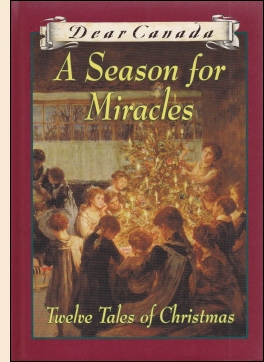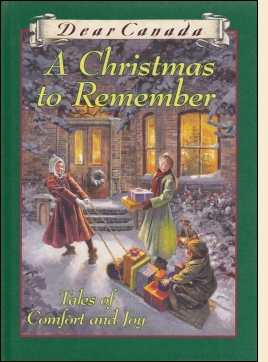| |

"Lawson spins a good yarn and
creates a compelling set of characters, some based on actual
historical figures and others who are purely fiction. It is not an easy
task to blend fact and fiction,
but Lawson is a pro and handles the challenges of the genre with ease."
— Island Parent
  The
Story behind the Stories The
Story behind the Stories
I first heard about Dear Canada when an editor
from Scholastic asked if I'd write for the series, specifically on the
history of the Canadian Pacific Railway. A daunting task! How could
I write about the CPR in the voice of a young girl who's keeping a diary
that covers only a year, with historical bits seeded throughout in a
believable way? And give the diary the shape of a story so it
could be read like a novel with a conflict that's resolved in the end?
Wait, there's more —
And write an epilogue to describe the life of the
diarist into adulthood and an extensive "Historical Note" to
give more information on the subject of the diary (that is, all the
stuff that a young girl would not record)? Hang on, still more
—
And search for archival images to give readers
a visual context to the story? And get permission to use them?
And write the captions? And address any comments or queries
raised by the fact-checkers and editors and the historical
experts who are called upon to vet all Dear Canada titles?
Could I do all that? To be honest, I didn't know! But
I was game to try.
Challenging? Yes! Rewarding? Absolutely!
I loved writing A Ribbon of Shining Steel. So
much so that the day it was launched I was pitching a proposal for a
diary of the Halifax Explosion. And even before No Safe Harbour was
published I was jotting down ideas for a third Dear Canada title.
The girls in these books became my girls and still live
on in my mind. Especially Charlotte of No Safe Harbour, who turned
out to be the closest to my twelve-year-old self. (Although Kate, in
A Ribbon of Shining Steel, is the character I would most like
to have been.)
I particularly enjoyed writing my Dear Canada
books because of the personal connections I had with each title. My
maternal grandfather, a Swedish immigrant, worked for the CPR from the
time he arrived in Canada until his retirement, and my paternal grandfather,
a multi-generation Nova Scotian, was a patient in a Halifax hospital
on December 6, 1917, the day of the explosion. Writing these novels
allowed me to delve into the history behind many of the stories I'd
heard as a child.
My third title in the series, Where the River Takes
Me, is largely set in the Hudson's Bay Company's Fort Victoria,
the birthplace of the city where I was born and raised (as were my parents
and paternal grandmother), and where I now make my home.
|
|

The Railway Diary of Kate Cameron
 CLA
Book of the Year Award, Short-list CLA
Book of the Year Award, Short-list
 Hackmatack
Award, Short-list Hackmatack
Award, Short-list
 Chocolate
Lily Award, Short-list Chocolate
Lily Award, Short-list
The building of the Canadian Pacific
Railway through BC's rugged Fraser Canyon was a treacherous undertaking,
and those involved in its construction — particularly the
Chinese labourers who blasted the tunnels — were in constant
danger. In her diary, Kate worries about her father's safety and
records the various accidents that take place. But her diary is
much more than that, as she paints a vivid picture of daily life
in the thriving town of Yale BC. Making friends (and losing them),
attending the one-room school, going on adventures with her older
brothers, suffering from the whooping cough, travelling to New
Westminster by steamer in order to have a tooth removed (torture!),
learning about "womanhood" from her mother, celebrating her 13th
birthday, rescuing a dog, getting caught in a fire — Kate's
life is anything but boring. As a budding journalist, she occasionally
works at the local newspaper, and takes great care in making her
diary entries accurate. Accurate in terms of her opinions, too!
She rails against the unfair treatment of the Chinese and the
racist attitudes of the period, even when it means a falling-out
with her best friend. Kate is anything but mild-mannered and ladylike.
She's gutsy, adventurous, unconventional, unflinchingly honest
and totally likeable (in my unbiased opinion).
|
 Reviews Reviews
|
Kate's spirited voice makes this an engaging
read … Historic detail about the building of the railway, attitudes
toward the Chinese and aboriginal labourers, gender expectations
and education make it illuminating.
Toronto Star
|
|
Kate's diary chronicles not only the challenges
and daily tragedies of the workers — scurvy, rock slides
and blasting accidents — but also the racism and callous
disregard that was shown the thousands of Chinese labourers. Interlaced
into this history is the wonderful story of Kate's struggles with
friendships, school and growing up in a raw and difficult place.
Lawson's obvious fascination with the railway makes this diary
both appealing and revealing.
Victoria Times-Colonist
|
|
Lawson has thoroughly researched the building
of the CPR through the Fraser Canyon. Further, the entries in
Kate's diary provide readers with a vivid portrait of life in
the late 1800s in this particular area of British Columbia. Indeed,
the diary entries include references to actual people and events
of the era, and Lawson effortlessly weaves "fact" into Kate's
fictional narratives.
CM Magazine
|
|

The Halifax Explosion Diary of Charlotte
Blackburn
 Winner
of the Hackmatack Award Winner
of the Hackmatack Award
 Runner-up
for the Chocolate Lily Award Runner-up
for the Chocolate Lily Award
The year
is 1917, and the world is at war. For her 12th birthday, Charlotte
receives a diary from her older brother Luke, a soldier fighting
in the trenches of France. He wants her to write about life on
"the Home Front" so that when he comes home, he'll be able to
read what he's missed. Charlotte leaps into the task, faithfully
recording the ups and downs of life at home, at school, and in
the city itself; the mischief-making and comic-book project she
undertakes with her twin brother Duncan; the bullying she endures
from her older sister; and the various activities that she and
her friends take part in for the War Effort. But life as she knows
it is about to change.
On December
6, 1917, the Mont-Blanc, a French steamer loaded with munitions,
collides with another ship in the Narrows of Halifax Harbour.
Almost at once the Mont-Blanc is on fire. The crew and pilot,
aware of the danger, take to the lifeboats and row to safety as
the abandoned ship drifts toward a pier at the north end of the
harbor. The fiery spectacle draws crowds of onlookers, unaware
that they are watching a floating bomb.
Twenty
minutes after the collision, the Mont-Blanc explodes. The
force blasts the 3,000-ton ship into a spray of metallic fragments
and instantly takes the lives of 1,600 people. Hundreds more perish
in the tsunami and fires that follow. Thousands are left injured
and homeless. Wounded and orphaned, Charlotte turns to her diary
to help her cope with the disaster and to keep her promise to
Luke by recording what happened. With her twin brother missing
and possibly dead, Luke may be her only surviving relative.
|
|
 Reviews Reviews
|
Author Julie Lawson lures readers into the
rhythm of daily life in Halifax at that time. This, of course,
makes the impact of the explosion feel even greater when it shatters
that rhythm. Even readers who have studied the Halifax Explosion
in school will find this fictional account to be absorbing, informative
and revelatory. Because Charlotte's journal entries continue well
beyond that fateful day, readers are given occasion to think about
how life resumed in the weeks and months following the disaster,
and how those affected had to pick up and carry on. And meanwhile,
the war in Europe was raging on, wreaking its own havoc on lives
all over the world.
CM Magazine
|
|
… Some of the emotional passages in No
Safe Harbour are intense, and give a feel for what the disaster
victims experience. But here, Lawson uses white space as effectively
as a musician uses silence. When Charlotte gets too upset, she
simply stops writing, sometimes in the middle of a sentence. We
can see her choking up and turning away as the tears spill over.
But Lawson is not manipulative. The emotion is appropriate for
the experience.
smartwriters.com
|
|
hi Julie … I just wanted to tell you that I
read No Safe Harbour. I loved it! I finished it in 2 days
and I couldn't put it down! I nearly cried when Duncan was thought
to be dead. It was like Charlotte and Duncan were my twins too!
I got so attached to the characters.
e-mail from a 12 year-old fan
|
|
|

The Hudson's Bay Company Diary
of Jenna Sinclair
 Bolen
Books Children's Book Prize, Finalist Bolen
Books Children's Book Prize, Finalist
Jenna's life is anything but dull! An orphan,
and rebellious from an early age, she lives in Fort Edmonton with
her prim aunt Grace who is quick to find fault with her high spirits
and tendency to break the rules. She has a kindred spirit in her
Cree Grandmother and in her Métis friend Suzanne, but soon she
moves south to Fort Colvile. The journey is long and difficult
but Jenna, an aspiring Novelist, relishes the spirit of Adventure
with a capital A.
Shortly after arriving at Fort Colvile,
she hears about a "real" school at Fort Victoria on Vancouver
Island, and persuades her aunt to let her attend. Another Adventure!
With a small brigade, she makes another harrowing journey down
rivers and over mountains to Fort Langley on the Fraser River,
and from there, she crosses the strait by canoe to Vancouver Island
and her new life at Fort Victoria. But even there, Jenna is restless.
School is horrible, and the teachers, real-life Rev. Staines
and Mrs. Staines, are even stricter than her aunt. It is not at
all what she expected.
Longing for more freedom, she sneaks
outside the fort walls, spies on the Company officers, and visits
the forbidden native village across the harbour. Through her exploits
she becomes embroiled in a mystery involving theft and attempted
murder, and finds more than she bargained for in the way of friends
— and enemies. She faithfully records her observations of
the world around her, describing three very different HBC trading
posts, and makes surprising discoveries about herself, and about
Heroes, Villains, and the unlikely places where Adventure can
be found.
|
 Reviews Reviews
|
Lawson's book has brought history to life.
She has perfectly conveyed the voice of a young girl, and Jenna
makes a connection with the reader because she seems so alive.
The diary format of the book is very realistic, and the epilogue,
which sums up the rest of Jenna's life, only adds to the reader's
belief that this may have been a real child. Where The River
Takes Me is a very good novel for anyone who even has a passing
interest in Canadian history.
CM Magazine
|
|
Lawson brings a taste of the culture of Canada's
west coast and the history of the Hudson's Bay Company into the
lives of her readers. The meadows are bright with blue camas and
chocolate lilies, and Jenna's Songhees friend Kwetlal introduces
her to the joys of soopolallie, a frothy delicacy unique
to the area. Lawson has created a lively, bouncing account that
wraps its history in an appealingly jaunty tale.
The Star
|
|

Twelve Tales of Christmas
A
collection of eleven original stories that give readers a chance
to reconnect with their favourite Dear Canada characters.
What's
Kate Cameron up to?
In
Stirring up a Storm, Kate is excited about her Grandma
Forrest coming to Yale to spend Christmas with the Camerons and
help out with Kate's new baby sister. Excited that is, until the
actual arrival of her formidable grandma! Fiery Kate stirs up
more than the plum pudding in a story that combines a missing
ring and a budding romance with the understanding that first impressions
should not always be trusted.
|

Scholastic Canada, 2006
ISBN: 978-0-439-95270-5
Also available in French
|

Scholastic Canada, 2009
ISBN: 978-0-545-99003-5
Also available in French
|

Tales of Comfort and Joy
Reunite with Jenna Sinclair, Charlotte
Blackburn and other Dear Canada girls in the second volume of
Christmas tales.
When War Hits Home
is an exchange of letters between Charlotte and her brother Luke,
a soldier who has recently been posted overseas. They are written
between December 1916 and January 1, 1917 — a year away from
the explosion in Halifax that will profoundly affect their lives.
Luke describes in humorous detail the military training he is
undergoing in England in preparation for the trench warfare in
France, and expresses his impatience to go "Over There" and "see
some action" before the war is over. While Luke is anxious to
fight the Germans, Charlotte is being shunned by classmates because
of her friendship with a girl whose father emigrated from Germany.
Where should her loyalty lie? With her best friend? Or with her
brother and the other girls? Her confusion comes through in her
letters as she struggles to make the right decision.
In The Daft Days of Christmas
Jenna Sinclair is living with her aunt and uncle and their 19-month-old
daughter at their remote farm outside of Fort Victoria. For the
first time she's celebrating both Christmas Day and the Scottish
New Year's (Hogmanay) not in an HBC fort but in a real home. Never
one to shy away from adventure, Jenna finds more than her share
when she ends up stranded at Fort Victoria during an unexpected
and severe snowstorm. Two nights of sharing a bed at the school
is enough, however, and she takes off on the long journey home
on her own. Or is she? Something (or someone) seems to be following
her. Later she discovers that her compulsive Storytelling and
blending of Fact and Fiction can have unforeseen consequences.
|
 Where
to Buy these books Where
to Buy these books
Titles in the Dear Canada series are available:
1. at your local bookstore or children's bookstore.
2. by placing an order with your local bookstore or online bookseller.
3. directly from the publisher, Scholastic
Canada. (1-800-268-3860)
4. as e-books from many e-book sellers.
[TOP] [BACK TO BOOKS
PAGE]
|
|





















